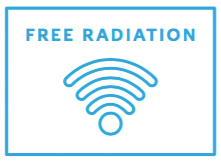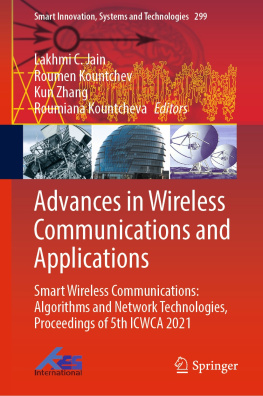
WIRELESS-WISE FAMILIES
Lyn McLean is Australias foremost consumer educator on the issue of electromagnetic radiation (EMR). She has been monitoring and writing on the subject for more than 20 years. Lyn is the author of Watts the Buzz , The Force , and Wireless-wise Kids , and is the publisher of the quarterly periodical EMR and Health . She has represented the community on various national committees and is director of EMR Australia.
Scribe Publications
1820 Edward St, Brunswick, Victoria 3056, Australia
2 John Street, Clerkenwell, London, WC1N 2ES, United Kingdom
First published by Scribe 2017
Copyright Lyn McLean 2017
All rights reserved. Without limiting the rights under copyright reserved above, no part of this publication may be reproduced, stored in or introduced into a retrieval system, or transmitted, in any form or by any means (electronic, mechanical, photocopying, recording or otherwise) without the prior written permission of the publishers of this book.
While every care has been taken to acknowledge copyright, the publisher tenders their apologies for any accidental infringement where copyright has proved untraceable. Where the attempt has been unsuccessful, the publisher welcomes information that would redress the situation.
Illustrations by Scribe
9781925322248 (paperback)
9781925548600 (e-book)
A CiP record for this title is available from the National Library of Australia.
scribepublications.com.au
scribepublications.co.uk
For Jacqueline and Alexandra
Contents
Appendix A:
Appendix B:
Appendix C:

Introduction
We love them, we depend on them, we fill our homes with them. We put them next to our sleeping babies and give them to our toddlers and children to play with. We use them for work, for entertainment, and for conducting our relationships.
Wireless devices are such a feature of modern life that chances are you use them, too.
But how much do you know about these devices and the radiation they emit?
Did you know, for example, that your use of wireless devices can affect your children, your unborn children, and even your chances of conceiving?
Did you know that wireless radiation has been shown to affect performance, health, mental health, relationships, and sleep?
Did you know that many world authorities recommend reducing exposure to this radiation?
If youre worried, youre not alone.
In this book, youll learn what you need to know about wireless radiation, how you and your family can use wireless devices more safely, and why. Youll have a better understanding of your familys exposure and will discover tips for reducing exposure if you choose. Youll also find useful suggestions for understanding and managing the impacts of wireless technologies on your home, your life, and the lives of your family.
Smart families are exposed to wireless radiation from smart devices.
Wise families make informed decisions about using wireless technologies safely.

Chapter 1
What Is Wireless Radiation?
Wireless devices emit radiofrequency radiation (RFR), sometimes known as wireless radiation, which is the term used in this book.
This radiation is also sometimes called high-frequency radiation, to differentiate it from the lower frequencies emitted by electrical equipment such as power lines.
Wireless devices work by sending and receiving information that is superimposed onto a radiofrequency signal. You could imagine that the wireless radiation is a train travelling from point A to point B. The information (voice, text, or image) is like the passengers it carries. If you block the journey of the train, there is no transfer of passengers. In the same way, if you block the radiation, there is no transfer of data. In other words, wireless networks rely on radiofrequency radiation to carry information.
Wireless networks are constantly transferring information from one wireless point to another, for example:
- from a mobile phone (cell phone) to a base station (cell tower)
- from a cordless handset to its base
- from a laptop to a modem
- from a tablet to a router.
One of the features of wireless radiation is its frequency, which is measured in units called hertz, usually in the range of megahertz (MHz) or gigahertz (GHz). Different technologies operate at different frequencies. Mobile phones generally operate at frequencies from 700 MHz to 2,600 MHz (2.6 GHz). Microwave ovens operate at 2.45 GHz the same frequency used for wi-fi.
The power of the radiation from a wireless device will depend on the area that the technology is designed to cover. A mobile phone might operate at low power if connecting to a mobile-phone base station nearby, but at much higher power if it were in a low-signal area like a lift or a rural area a long way from a base station.
How much exposure you receive from a wireless device will depend on two things the power of its signal and the distance between you. The highest exposure occurs close to a wireless device, such as when your mobile phone is directly against your head or your body, or when youre standing close to a router or cordless phone. However, keep in mind that wireless radiation is nevertheless designed to transmit over distances up to many kilometres in the case of some mobile-phone base stations.
Over the years, advertisers have coined a range of terms as alternatives to the word radiation, which has negative connotations. Conversely, theyve invented negative terms to apply to radiation-free zones. Here are some of those terms and what they really mean:
- energy radiofrequency radiation
- signal radiofrequency radiation
- reception radiofrequency radiation
- wireless radiofrequency radiation
- wi-fi radiofrequency radiation
- Bluetooth radiofrequency radiation
- smart meter/TV/appliance one that emits radiofrequency radiation
- coverage an area covered in radiofrequency radiation
- connect send a signal of radiofrequency radiation to and from
- black spot a radiation-free zone
Would you be as pleased to take advantage of this offer if the sign said Free radiation?


Chapter 2
Why Take Precautions?
When you bought the wireless devices in your home, you probably thought they were safe. Theyd have to be safe to be sold on the market, wouldnt they? Its a reasonable assumption but, unfortunately, its not necessarily true.
Across the world, more and more concerns are emerging about the risks of wireless radiation, particularly for long-term exposure. Here are just some of the concerns raised so far.
Cancer risks
In 2011, the International Agency for Research on Cancer (IARC) classified radiofrequency radiation as a Class 2B (possible) carcinogen, in the same category as lead. IARC made this decision on the basis of two groups of studies (one by the Interphone team and one by Swedish oncologist Professor Lennart Hardell) both of which found higher risks of some brain tumours among heavy and long-term mobile-phone users, even though the phones they used complied with relevant standards.
Next page



















